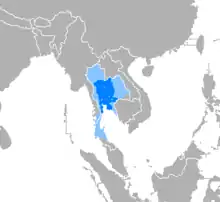ထိုင်းဘာသာစကား
ထိုင်းဘာသာစကား (ထိုင်း: ภาษาไทย)ကို ဆိုင်းယမ် (သို့မဟုတ်) ထိုင်းအလယ်ပိုင်းစကားဟုလည်း ခေါ်လေ့ရှိပြီး ထိုင်းနိုင်ငံ တရားဝင်ရုံးသုံးဘာသာစကား နှင့် ထိုင်းလူမျိုး( ယိုးဒယားရောက်မြန်မာတို့က ရှမ်း ဟုခေါ်သည်)၊ ထိုင်းတရုတ်လူမျိုးများ၏ မိခင်ဘာသာစကားလည်း ဖြစ်သည်။ ထိုင်းဘာသာစကားသည် တိုင်-ကဒိုင်း ဘာသာစကားမိသားစုဝင် တိုင်ဘာသာစကားတစ်ခု ဖြစ်သည်။ ထိုင်းဘာသာစကား၏ ဝေါဟာရ တစ်ဝက်ကျော်ကျော်သည် ပါဠိ၊ သက္ကတ နှင့် ခမာဘာသာစကားတို့မှ မွေးစားထားသည်။ ထိုင်းဘာသာစကားသည် တက်ကျသံရှိသော (tonal)၊ သရုပ်ခွဲဘာသာစကား( analytic) တစ်ခုဖြစ်သည်။ ထိုင်းစကားပြောသည် လာအိုစကားပြော နှင့် အပြန်အလှန် တူညီကြပြီး ဘာသာစကားနှစ်ခုသည် စာရေးသားရာမှ အနည်းငယ်ကွဲလွဲသော်လည်း ဘာသာဗေဒအရ အတူတူပင်ဖြစ်သည်။[3]
| ထိုင်း | |
|---|---|
| သယာမ်မိစ် | |
| ภาษาไทย ဘာၑါထိုင်း | |
| အသံထွက် | [pʰāːsǎː tʰāj] |
| ဒေသခံ | ထိုင်းနိုင်ငံ |
| လူမျိုးစု | အလယ်ပိုင်းထိုင်း ထိုင်း နှင့် ထိုင်းတရုတ် |
ဒေသခံ ပြောဆိုသူများ | ၂၀,၀၀၀,၀၀၀ (၂၀၀၀)[1] သန်း ၄၀ ဒုတိယဘာသာစကားအနေဖြင့် ပြောဆိုသူ နှင့် လနာ၊ အီဆန်၊ တောင်ပိုင်းထိုင်းဘာသာ သို့ မြောက်ပိုင်းခမာ (၂၀၀၁)[1] |
တိုင်-ကဒိုင်း
| |
စာအရေးအသားစနစ် | ထိုင်းအက္ခရာ ထိုင်းမျက်မမြင်စာ |
| တရားဝင် အခြေအနေ | |
ရုံးသုံး အဖြစ် အသုံးပြုမှု | ထိုင်းနိုင်ငံ |
| တရားဝင် ထိန်းသိမ်းသူ | ထိုင်းနိုင်ငံတော်ဝင်အသင်း |
| ဘာသာစကားကုဒ်များ | |
| ISO 639-1 | th |
| ISO 639-2 | tha |
| ISO 639-3 | tha |
| Glottolog | thai1261[2] |
| Linguasphere | 47-AAA-b |
 | |
ဒေသိယဘာသာစကား နှင့် ဆက်စပ်ဘာသာစကားများ
ထိုင်းဘာသာစကားသည် ထိုင်းနိုင်ငံ၏ တရားဝင် ရုံးသုံးဘာသာစကား ဖြစ်ပြီး လူဦးရေ သန်း(၂၀)ကျော် (၂၀၀၀ ခုနှစ်) သုံးစွဲလျက်ရှိသည်။ စံပြထိုင်းဘာသာစကားသည် ဘန်ကောက် [4][5]ပညာတတ်အသိုက်အဝန်း၏ စကားပြောဆိုမူပေါ်တွင် အခြေခံသည်။ ထိုင်းအလယ်ပိုင်းစကား အပြင်၊ ထိုင်းနိုင်ငံသည် အခြားဆက်စပ်သော တိုင်ဘာသာစကားတို့၏ မူရင်းဒေသလည်း ဖြစ်သည်။ ဘာသာဗေဒ ပညာရှင်များက ဤ ပေါရာဏ/ကွဲပြားမှုအသုံးတွေကို ဆက်စပ်သည်ဟု ဆိုသော်လည်း မတူကွဲပြား ထူးခြားနေသော ဤဘာသာစကားများ၏ မူလပြောဆိုသူများက ဤသည်မှာ ဘာသာစကား၏ ကြွယ်ဝမှု (သို့မဟုတ်) တူညီသော ထိုင်းဘာသာစကား၏ဒေသိယအသုံး/ ထိုင်းဘာသာစကား၏ ကွဲလွဲမှုသာ ဖြစ်သည်ဟု ဆိုပါသည်။[6]
ဆက်စပ်ဘာသာစကားများ
ထိုင်းအလယ်ပိုင်းစကား
- အရှေ့အလယ်ပိုင်းထိုင်းစကား
- အယုဒ္ဓ ဒေသိယ စကား
ကိုးကား
- ထိုင်း at Ethnologue (18th ed., 2015)
- Nordhoff၊ Sebastian; Hammarström၊ Harald; Forkel၊ Robert; Haspelmath၊ Martin, eds. (2013)။ "Thai"။ Glottolog။ Leipzig: Max Planck Institute for Evolutionary Anthropology။
- Ausbau and Abstand languages
- Andrew Simpson (2007)။ Language and national identity in Asia။ Oxford University Press။
Standard Thai is a form of Central Thai based on the variety of Thai spoken earlier by the elite of the court, and now by the educated middle and upper classes of Bangkok. It ... was standardized in grammar books in the nineteenth century, and spread dramatically from the 1930s onwards, when public education became much more widespread
- Peansiri Vongvipanond (Summer 1994)။ Linguistic Perspectives of Thai Culture။ paper presented to a workshop of teachers of social science။ University of New Orleans။ 26 April 2011 တွင် ပြန်စစ်ပြီး။ “The dialect one hears on radio and television is the Bangkok dialect, considered the standard dialect.”
- Antonio L. Rappa; Lionel Wee (2006)၊ Language Policy and Modernity in Southeast Asia: Malaysia, the Philippines, Singapore, and Thailand၊ Springer၊ pp. 114–115